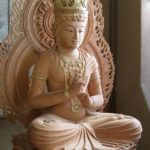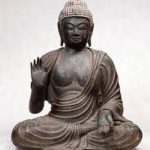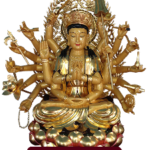大日如来(だいにちにょらい、梵: Mahāvairocana

釈迦如来(しゃかにょらい、しきゃじらい)または釈迦牟尼仏(しゃかむにぶつ)とは、仏教の開祖である釈迦(ゴータマ・シッダッタ、ガウタマ・シッダールタ、瞿曇悉達多)を、仏(仏陀)として敬う呼び名である

准胝観音(じゅんでいかんのん、じゅんていかんのん)は、仏教における信仰対象である菩薩の一尊
三身(さんじん、または さんしん、梵: trikāya)は、大乗仏教における、仏の3種類の身のあり方(法身・報身・応身)で、仏身観の一種である。三身説。
『十地経論』巻3には「一切の仏に三種の仏あり。一に応身仏、二に報身仏、三に法身仏なり」とある。通常はこの三身説がよく用いられる。
対応関係を表すと次の通り。
三身が具現していることを、三身即一、あるいは三身円満などという。
法身仏(真理そのものであるような仏)とは、一切の分け隔てを離れた仏の無分別智の領域をいい、仏陀のさとりの本体です。そこでは知る者と知られる者が一つであり、生と死、自と他、愛と憎しみ、善と悪といった二元的な対立を完全に超え、時間的・空間的な制約もありませんから、物事を対象的に捉え、分別し区別することを特徴としている言葉では表せない領域です。それを仮りに一如とも真如とも法性とも法身仏とも法性土ともいいますが、そこでは生死もなく、往来の相も離れていますから往生ということばさえもありません。
報身仏とは、菩薩が自らのさとりを完成すると同時に、一切の衆生を救済しようという誓願を起し、永劫にわたる修行によって完成された万徳円満の仏陀です。それは無量の願と徳を実現していますから永遠の"いのち"(無量寿)と、無限の智慧の光(無量光)を持っています。そのような報身仏の領域を報土といいますが、そこには菩薩であった時に誓われたとおり、真如にかなった真実の世界が実現されています。
もっとも一般には、同じ報身・報土であっても菩薩の智慧の程度に応じて、感得できる報土には上下の隔てがあると考えられていました。しかし少なくとも愛憎の煩悩を断ち切り、真如の一分をさとる智慧を開いた初地以上の菩薩 (天台宗では初住以上の菩薩) でなければ感得することができないというのが仏教の常識でした。初地とは、五十一段階に分けられる菩薩の階位の第四十一位目をいい、見惑 (邪師や邪教によって後天的に起こすようになった煩悩) とか思惑 (生まれつき持っている極めて根深い煩悩) といわれるような、無量の煩悩を断ち切って、もはや迷いの境界(三界)を輪廻転生しなくなった菩薩ですから、これ以上を聖者といいます。
このように初地以上の菩薩が、それぞれのさとりの、さとりの程度に応じて感得する報土を他受用報土(他の菩薩に受用させる報土・天台宗では実報無障礙土) といいます。仏が完成された仏界としての報土は仏陀だけが受用されますので自受用報土 (天台宗では常寂光土) と呼んで区別されていました。ですからたとえ弥勒菩薩のような最高位 (第五十一位) の菩薩であっても真実の報土 (自受用報土) は窺い知ることはできないといわれていました。このような通説を完全に破って、信心の行者が往生させていただく報土は、真実報土であって、ただ仏と仏とのみが知見することのできる無上涅槃の境界であるといい、往生はそのまま成仏であると言い切っていかれたのが親鸞聖人でした。
愛憎の煩悩を燃やし続けている凡夫や、煩悩を制御して表には現れなくなってはいるが、まだ真如をさとる智慧が開けていない修行者の心に応じて現れている仏を応身仏といいます。そのなかには人間に応じてこの娑婆(穢土)に現れて来られた釈尊のような八十歳で入滅される仏身もあります。
Dainichi Nyorai (Dainichinyorai, Bonn: Mahāvairocana

Shaka Nyorai or Shaka Munibutsu means the Buddha's founder, Buddha (Gautama Siddatta, Gautama Siddhartha, and Shakudani Tadata) Buddha)

Jundai Kannon is one of the bodhisattvas who is a religious object in Buddhism.

Sanjin (or Sanshin, San: Sankaku:) trikāya) are the three types of body of Buddha in Mahayana Buddhism (Holy body, sacred body, and body), which is a kind of Buddha's view. Three-way theory.
Volume 3 of "Tenjikyoron" states that "There are three kinds of Buddha in every Buddha. First is a Buddha, second is a Buddha, and third is a Buddha." Usually, this three body theory is often used.
The correspondence is as follows.
Description of the three bodies Santoku Buddha (Horai) Hoshin: Truth of the universe, truth itself, the Buddha nature. Hojin Bi Roh Buddha Hojin: The attribute of Buddhism and its function. Or a figure of practicing and becoming Buddha. Hanwa Amitabha Buddha (Ojin) The figure of Buddha who is enlightened in this world and appears in front of people. Liberation Sakyamuni Buddha
What the three bodies embody is called the first three bodies, or the third body Enmitsu.
Sword
Buddhist Buddha (the Buddha as it is the truth itself) refers to the realm of indiscriminate wisdom of the Buddha, which is the body of the Satori of the Buddha. There is only one person who knows and knows there, and it completely transcends the dual confrontation of life and death, self and others, love and hate, good and evil, and there is no time or space restriction. , Is an area that cannot be expressed in words, which is characterized by targeting things, separating them, and distinguishing them. Although it is also called legality, legality, Buddhism, Buddha, and legal soil, there is no life or death there, and there is no difference between traffic and traffic.
Body
The Buddhist Buddha is a Buddhist Buddhist statue of Mantoku Enman who was completed by his long-term training as the Bodhisattva completed his own satori and at the same time made a vow to save all sentient beings. It realizes an infinite amount of desires and virtue, so it has eternal "life" (infinite life) and infinite light of wisdom (infinite light). The territory of such a Buddha is called Hodo, where the true world of truth is realized, as promised when he was a Bodhisattva.
However, it was generally considered that even the same body and body, there was a gap between the top and bottom that could be felt, depending on the degree of bodhisattva's wisdom. However, the common sense of Buddhism was that at least the Bodhisattva above the first land (the Bodhisattva above the first residence in the Tendai sect), who at least cut off the anxieties of love and hate and opened up the wisdom of the true heart, was the only common sense. Hajime is the forty-first place of the Bodhisattva's rank, which is divided into fifty-one stages, and is used for confusion (anxiety caused by evil teachers and priests) and speculation (born naturally). It is a bodhisattva that has no longer reincarnated from the boundary (third world) in which he is lost by cutting off an infinite amount of anxiety, which is said to be extremely deep-rooted anxiety.
In this way, Bodhisattva above the first ground is said to have received the soil that each Satori feels according to the degree of Satori. I will. Only the Buddha can accept the Buddhist information as the Buddhist world where the Buddha was completed. Therefore, it was said that even the highest-ranking Bodhisattva like the Maitreya Bodhisattva (the 51st place) could not know the true Hodo (self-supporting Hodo). It is said that the hodo that the devotee's devotee revives after breaking such a popular theory is the true hodo, is the border between the Buddha and the Nirvana, which only Buddha can know. It was Shinran Saint who was said to have been a true Buddha.
Response
The Buddha who has continued to burn the anxieties of love and hate, and the Buddha who has been able to control his anxieties and is no longer appearing in the table, but who has appeared according to the mind of the practitioner who has yet to open his true wisdom. Says. Among them, there is a Buddhist shrine that was eradicated at the age of 80, like Shakyamuni, who appeared in this poem according to human beings.

釈迦如来(しゃかにょらい、しきゃじらい)または釈迦牟尼仏(しゃかむにぶつ)とは、仏教の開祖である釈迦(ゴータマ・シッダッタ、ガウタマ・シッダールタ、瞿曇悉達多)を、仏(仏陀)として敬う呼び名である

准胝観音(じゅんでいかんのん、じゅんていかんのん)は、仏教における信仰対象である菩薩の一尊

三身(さんじん、または さんしん、梵: trikāya)は、大乗仏教における、仏の3種類の身のあり方(法身・報身・応身)で、仏身観の一種である。三身説。
『十地経論』巻3には「一切の仏に三種の仏あり。一に応身仏、二に報身仏、三に法身仏なり」とある。通常はこの三身説がよく用いられる。
対応関係を表すと次の通り。
| 三身 | 説明 | 三徳 | 仏(如来) |
|---|---|---|---|
| 法身(ほっしん) | 宇宙の真理・真如そのもの、仏性。 | 法身 | 毘盧遮那仏 |
| 報身(ほうじん) | 仏性のもつ属性、はたらき。あるいは修行して成仏する姿。 | 般若 | 阿弥陀仏 |
| 応身(おうじん) | この世において悟り、人々の前に現れる釈迦の姿。 | 解脱 | 釈迦牟尼仏 |
三身が具現していることを、三身即一、あるいは三身円満などという。
法身
法身仏(真理そのものであるような仏)とは、一切の分け隔てを離れた仏の無分別智の領域をいい、仏陀のさとりの本体です。そこでは知る者と知られる者が一つであり、生と死、自と他、愛と憎しみ、善と悪といった二元的な対立を完全に超え、時間的・空間的な制約もありませんから、物事を対象的に捉え、分別し区別することを特徴としている言葉では表せない領域です。それを仮りに一如とも真如とも法性とも法身仏とも法性土ともいいますが、そこでは生死もなく、往来の相も離れていますから往生ということばさえもありません。
報身
報身仏とは、菩薩が自らのさとりを完成すると同時に、一切の衆生を救済しようという誓願を起し、永劫にわたる修行によって完成された万徳円満の仏陀です。それは無量の願と徳を実現していますから永遠の"いのち"(無量寿)と、無限の智慧の光(無量光)を持っています。そのような報身仏の領域を報土といいますが、そこには菩薩であった時に誓われたとおり、真如にかなった真実の世界が実現されています。
もっとも一般には、同じ報身・報土であっても菩薩の智慧の程度に応じて、感得できる報土には上下の隔てがあると考えられていました。しかし少なくとも愛憎の煩悩を断ち切り、真如の一分をさとる智慧を開いた初地以上の菩薩 (天台宗では初住以上の菩薩) でなければ感得することができないというのが仏教の常識でした。初地とは、五十一段階に分けられる菩薩の階位の第四十一位目をいい、見惑 (邪師や邪教によって後天的に起こすようになった煩悩) とか思惑 (生まれつき持っている極めて根深い煩悩) といわれるような、無量の煩悩を断ち切って、もはや迷いの境界(三界)を輪廻転生しなくなった菩薩ですから、これ以上を聖者といいます。
このように初地以上の菩薩が、それぞれのさとりの、さとりの程度に応じて感得する報土を他受用報土(他の菩薩に受用させる報土・天台宗では実報無障礙土) といいます。仏が完成された仏界としての報土は仏陀だけが受用されますので自受用報土 (天台宗では常寂光土) と呼んで区別されていました。ですからたとえ弥勒菩薩のような最高位 (第五十一位) の菩薩であっても真実の報土 (自受用報土) は窺い知ることはできないといわれていました。このような通説を完全に破って、信心の行者が往生させていただく報土は、真実報土であって、ただ仏と仏とのみが知見することのできる無上涅槃の境界であるといい、往生はそのまま成仏であると言い切っていかれたのが親鸞聖人でした。
応身
愛憎の煩悩を燃やし続けている凡夫や、煩悩を制御して表には現れなくなってはいるが、まだ真如をさとる智慧が開けていない修行者の心に応じて現れている仏を応身仏といいます。そのなかには人間に応じてこの娑婆(穢土)に現れて来られた釈尊のような八十歳で入滅される仏身もあります。
Dainichi Nyorai (Dainichinyorai, Bonn: Mahāvairocana

Shaka Nyorai or Shaka Munibutsu means the Buddha's founder, Buddha (Gautama Siddatta, Gautama Siddhartha, and Shakudani Tadata) Buddha)

Jundai Kannon is one of the bodhisattvas who is a religious object in Buddhism.

Sanjin (or Sanshin, San: Sankaku:) trikāya) are the three types of body of Buddha in Mahayana Buddhism (Holy body, sacred body, and body), which is a kind of Buddha's view. Three-way theory.
Volume 3 of "Tenjikyoron" states that "There are three kinds of Buddha in every Buddha. First is a Buddha, second is a Buddha, and third is a Buddha." Usually, this three body theory is often used.
The correspondence is as follows.
Description of the three bodies Santoku Buddha (Horai) Hoshin: Truth of the universe, truth itself, the Buddha nature. Hojin Bi Roh Buddha Hojin: The attribute of Buddhism and its function. Or a figure of practicing and becoming Buddha. Hanwa Amitabha Buddha (Ojin) The figure of Buddha who is enlightened in this world and appears in front of people. Liberation Sakyamuni Buddha
What the three bodies embody is called the first three bodies, or the third body Enmitsu.
Sword
Buddhist Buddha (the Buddha as it is the truth itself) refers to the realm of indiscriminate wisdom of the Buddha, which is the body of the Satori of the Buddha. There is only one person who knows and knows there, and it completely transcends the dual confrontation of life and death, self and others, love and hate, good and evil, and there is no time or space restriction. , Is an area that cannot be expressed in words, which is characterized by targeting things, separating them, and distinguishing them. Although it is also called legality, legality, Buddhism, Buddha, and legal soil, there is no life or death there, and there is no difference between traffic and traffic.
Body
The Buddhist Buddha is a Buddhist Buddhist statue of Mantoku Enman who was completed by his long-term training as the Bodhisattva completed his own satori and at the same time made a vow to save all sentient beings. It realizes an infinite amount of desires and virtue, so it has eternal "life" (infinite life) and infinite light of wisdom (infinite light). The territory of such a Buddha is called Hodo, where the true world of truth is realized, as promised when he was a Bodhisattva.
However, it was generally considered that even the same body and body, there was a gap between the top and bottom that could be felt, depending on the degree of bodhisattva's wisdom. However, the common sense of Buddhism was that at least the Bodhisattva above the first land (the Bodhisattva above the first residence in the Tendai sect), who at least cut off the anxieties of love and hate and opened up the wisdom of the true heart, was the only common sense. Hajime is the forty-first place of the Bodhisattva's rank, which is divided into fifty-one stages, and is used for confusion (anxiety caused by evil teachers and priests) and speculation (born naturally). It is a bodhisattva that has no longer reincarnated from the boundary (third world) in which he is lost by cutting off an infinite amount of anxiety, which is said to be extremely deep-rooted anxiety.
In this way, Bodhisattva above the first ground is said to have received the soil that each Satori feels according to the degree of Satori. I will. Only the Buddha can accept the Buddhist information as the Buddhist world where the Buddha was completed. Therefore, it was said that even the highest-ranking Bodhisattva like the Maitreya Bodhisattva (the 51st place) could not know the true Hodo (self-supporting Hodo). It is said that the hodo that the devotee's devotee revives after breaking such a popular theory is the true hodo, is the border between the Buddha and the Nirvana, which only Buddha can know. It was Shinran Saint who was said to have been a true Buddha.
Response
The Buddha who has continued to burn the anxieties of love and hate, and the Buddha who has been able to control his anxieties and is no longer appearing in the table, but who has appeared according to the mind of the practitioner who has yet to open his true wisdom. Says. Among them, there is a Buddhist shrine that was eradicated at the age of 80, like Shakyamuni, who appeared in this poem according to human beings.












 オシャレ感あふれるグッズならそれだけで話が盛り上がります。写真はドウシシャ「LiVE もくもくクイックスモーカー L」
オシャレ感あふれるグッズならそれだけで話が盛り上がります。写真はドウシシャ「LiVE もくもくクイックスモーカー L」 サンコーレアモノショップ「卓上ひとり焼肉プレート」
サンコーレアモノショップ「卓上ひとり焼肉プレート」 BRUNO「コンパクトホットプレート」平面プレート利用時
BRUNO「コンパクトホットプレート」平面プレート利用時


 ドウシシャ「LiVE もくもくクイックスモーカーS」
ドウシシャ「LiVE もくもくクイックスモーカーS」
 recolte「ラクレット&フォンデュメーカー メルト」
recolte「ラクレット&フォンデュメーカー メルト」
 サンコーレアモノショップ「俺の自販機」
サンコーレアモノショップ「俺の自販機」




 私たちの筋肉や骨、皮膚、臓器、毛髪、血液、酵素、ホルモンなどをつくる原料となるのがタンパク質で、約20種類のアミノ酸が結合してできています。
私たちの筋肉や骨、皮膚、臓器、毛髪、血液、酵素、ホルモンなどをつくる原料となるのがタンパク質で、約20種類のアミノ酸が結合してできています。





